Cas IIgly induces apoptosis in glioma C6 cells in vitro and in vivo through caspase-dependent and caspase-independent mechanisms
- PMID: 16036107
- PMCID: PMC1501287
- DOI: 10.1593/neo.04607
Cas IIgly induces apoptosis in glioma C6 cells in vitro and in vivo through caspase-dependent and caspase-independent mechanisms
Abstract
In this work, we investigated the effects of Casiopeina II-gly (Cas IIgly)--a new copper compound exhibiting antineoplastic activity--on glioma C6 cells under both in vitro and in vivo conditions, as an approach to identify potential therapeutic agents against malignant glioma. The exposure of C6 cells to Cas IIgly significantly inhibited cell proliferation, increased reactive oxygen species (ROS) formation, and induced apoptosis in a dose-dependent manner. In cultured C6 cells, Cas IIgly caused mitochondrio-nuclear translocation of apoptosis induction factor (AIF) and endonuclease G at all concentrations tested; in contrast, fragmentation of nucleosomal DNA, cytochrome c release, and caspase-3 activation were observed at high concentrations. Administration of N-acetyl-L-cystein, an antioxidant, resulted in significant inhibition of AIF translocation, nucleosomal DNA fragmentation, and caspase-3 activation induced by Cas IIgly. These results suggest that caspase-dependent and caspase-independent pathways both participate in apoptotic events elicited by Cas IIgly. ROS formation induced by Cas IIgly might also be involved in the mitochondrio-nuclear translocation of AIF and apoptosis. In addition, treatment of glioma C6-positive rats with Cas IIgly reduced tumor volume and mitotic and cell proliferation indexes, and increased apoptotic index. Our findings support the use of Cas IIgly for the treatment of malignant gliomas.
Figures
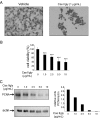
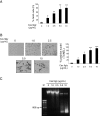
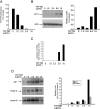
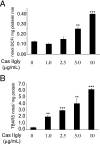
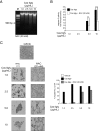

Similar articles
-
Danthron triggers ROS and mitochondria-mediated apoptotic death in C6 rat glioma cells through caspase cascades, apoptosis-inducing factor and endonuclease G multiple signaling.Neurochem Res. 2012 Aug;37(8):1790-800. doi: 10.1007/s11064-012-0792-3. Epub 2012 May 17. Neurochem Res. 2012. PMID: 22592642
-
Copper compound induces autophagy and apoptosis of glioma cells by reactive oxygen species and JNK activation.BMC Cancer. 2012 Apr 27;12:156. doi: 10.1186/1471-2407-12-156. BMC Cancer. 2012. PMID: 22540380 Free PMC article.
-
Involvement of reactive oxygen species and caspase-dependent pathway in berberine-induced cell cycle arrest and apoptosis in C6 rat glioma cells.Int J Oncol. 2009 Jun;34(6):1681-90. doi: 10.3892/ijo_00000299. Int J Oncol. 2009. PMID: 19424587
-
Casiopeína IIgly-induced oxidative stress and mitochondrial dysfunction in human lung cancer A549 and H157 cells.Toxicology. 2010 Feb 9;268(3):176-83. doi: 10.1016/j.tox.2009.12.010. Epub 2009 Dec 23. Toxicology. 2010. PMID: 20026372 Free PMC article.
-
Arachidonic acid converts the glutathione depletion-induced apoptosis to necrosis by promoting lipid peroxidation and reducing caspase-3 activity in rat glioma cells.Arch Biochem Biophys. 2002 Apr 1;400(1):133-40. doi: 10.1006/abbi.2002.2784. Arch Biochem Biophys. 2002. PMID: 11913980
Cited by
-
1H -NMR Metabolomics Study of the Effect of Cisplatin and Casiopeina IIgly on MDA-MB-231 Breast Tumor Cells.Front Mol Biosci. 2021 Dec 1;8:742859. doi: 10.3389/fmolb.2021.742859. eCollection 2021. Front Mol Biosci. 2021. PMID: 34926572 Free PMC article.
-
Antitumoral and Antimetastatic Activity by Mixed Chelate Copper(II) Compounds (Casiopeínas®) on Triple-Negative Breast Cancer, In Vitro and In Vivo Models.Int J Mol Sci. 2024 Aug 13;25(16):8803. doi: 10.3390/ijms25168803. Int J Mol Sci. 2024. PMID: 39201489 Free PMC article.
-
Porphyrins as ligands for 64copper: background and trends.Medchemcomm. 2018 Aug 17;9(10):1577-1588. doi: 10.1039/c8md00263k. eCollection 2018 Oct 1. Medchemcomm. 2018. PMID: 30429966 Free PMC article. Review.
-
Antineoplastic copper coordinated complexes (Casiopeinas) uncouple oxidative phosphorylation and induce mitochondrial permeability transition in cardiac mitochondria and cardiomyocytes.J Bioenerg Biomembr. 2016 Feb;48(1):43-54. doi: 10.1007/s10863-015-9640-x. Epub 2016 Jan 7. J Bioenerg Biomembr. 2016. PMID: 26739598
-
Metabolic Roles of HIF1, c-Myc, and p53 in Glioma Cells.Metabolites. 2024 Apr 25;14(5):249. doi: 10.3390/metabo14050249. Metabolites. 2024. PMID: 38786726 Free PMC article. Review.
References
-
- Kerr JF, Winterford CM, Harmon BV. Apoptosis. Its significance in cancer and cancer therapy. Cancer. 1994;73:2013–2026. - PubMed
-
- Green DR, Reed JC. Mitochondria and apoptosis. Science. 1998;28:1309–1312. - PubMed
-
- Green D, Kroemer G. The central executioners of apoptosis: caspases or mitochondria? Trends Cell Biol. 1998;8:267–271. - PubMed
Publication types
MeSH terms
Substances
LinkOut - more resources
Full Text Sources
Research Materials
